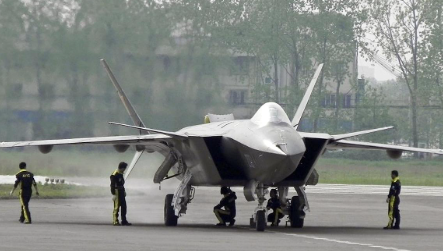Race for Fighters: India’s Dilemma in Aircraft Modernisation (GS Paper 3, Defence)

Context
- China’s unveiling of two new stealth fighter jets, along with its growing technological prowess in military aviation, has sparked a fresh wave of scrutiny about India’s defence preparedness.
- While China advances rapidly, India is grappling with several challenges in modernizing its air force.
- This gap in capabilities highlights the urgency with which India must address its aircraft fleet requirements.
Chinese Military Modernisation
China’s air force modernization is making rapid strides, with the country now fielding two advanced fifth-generation fighter jets:
- J-35: A medium fighter
- J-20: A heavy fighter
China’s fleet of advanced fighters makes it one of the only countries, besides the United States, with two fifth-generation fighter jets. Further, China’s unveiling of two stealth jets in tail-less configurations, believed to be sixth-generation prototypes, suggests that China is gearing up to dominate the future of aviation warfare. Among the two, one features a delta-wing design with three engines, highlighting its long-range potential, while the other adopts a smaller twin-engine design for tactical versatility.
China's Air Force and Naval Aviation together form the largest aviation force in the Indo-Pacific region, comprising over 1,300 fourth-generation fighters, equipped with technology comparable to U.S. standards. Additionally, China has secured approval from Pakistan to supply 40 J-35s (fifth-generation jets).
India’s Aircraft Fleet
- The Indian Air Force (IAF) currently operates 31 fighter squadrons, significantly short of the sanctioned strength of 42 squadrons.
- This shortfall hampers the IAF's optimal operational readiness.
- The MIG-21 squadrons are being phased out, but the delayed delivery of LCA-Mk1A jets has extended their service life.
- At present, the IAF has acquired 36 Rafale jets (4.5 generation) from France in a government-to-government deal in 2016, but India remains without a fifth-generation fighter aircraft, with no such aircraft expected to be inducted before the next decade.
India’s Modernisation Plans
India has laid out ambitious plans to modernize its air force with the goal of acquiring over 500 fighter jets, primarily of indigenous design and manufacture. Key projects under development include:
LCA-MK1A (Tejas)
- India has placed an order for 83 units of the Tejas MK1A with Hindustan Aeronautics Limited (HAL).
- However, the delivery of these jets has been delayed due to supply chain issues, particularly with the F-404 engines from General Electric.
- The Tejas is a 4th-generation light fighter aircraft, and though promising, it has yet to fully meet the IAF’s operational needs.
LCA-MK2 (Tejas 2)
- The LCA Mk2, an improved version of Tejas with enhanced features, is expected to enter production by 2029-2030.
- It will be powered by the GE-414 engine and is seen as an upgrade to India’s current fleet.
- The IAF plans to induct around six squadrons of the LCA Mk2 by the mid-2030s.
AMCA Mk2 (Advanced Medium Combat Aircraft)
- India’s AMCA Mk2, a 5th-generation stealth fighter, is currently under development.
- The aircraft, once it enters mass production (expected after 2035), will be a crucial step towards India’s self-reliance in military aviation.
TED-BF for Navy
- India is developing the Twin Engine Deck Based Fighter (TED-BF) to replace its aging MiG-29K fleet in the Navy.
- The first prototype of TED-BF is expected to take flight by 2026, with production commencing by 2031.
Procurement of 114 Multi-Role Fighter Aircraft (MRFA)
- The Ministry of Defence (MoD) is also pursuing a major procurement of 114 MRFA jets to meet its air superiority needs.
- This ambitious project involves an open tender and will further shape the future of India’s air combat capabilities.
Challenges in India’s Aircraft Modernisation
Delay in Acquisitions
- The LCA-Mk1A and LCA-Mk2 aircraft have faced significant delays in production, primarily due to issues in engine supply chains.
- The AMCA Mk2, a fifth-generation aircraft, is unlikely to be operational until at least 2035, which places India at a considerable disadvantage against rapidly modernizing adversaries like China.
Squadron Shortfalls
- The IAF is struggling with a severe shortage of squadrons.
- The phased-out MiG-21s, Mirage-2000s, and Jaguars will further exacerbate the issue, leading to a projected fleet of only 35-36 squadrons by 2035.
- This falls well short of the optimal 42 squadrons needed for adequate deterrence and defense.
Dependence on Foreign Engines
- A significant hurdle to India’s self-reliance is its dependence on foreign-made aero-engines for both indigenous jets and helicopters.
- India’s reliance on imported F-414 engines (from the U.S.) and 110KN engines (from France) underscores the criticality of foreign partnerships in India’s defence manufacturing sector.
India cannot claim to be truly self-reliant until it develops its own indigenous aero-engine, capable of powering advanced fighter aircraft without dependence on foreign suppliers.
Conclusion
- India’s journey towards a modernized air force is fraught with challenges, ranging from delayed acquisitions and technological gaps to strategic vulnerabilities arising from squadron shortfalls.
- The growing technological advancements of China, coupled with its strong military alliances, further accentuate the urgency for India to ramp up its defense modernization efforts.
- While India’s current focus on indigenous manufacturing, such as the LCA-Mk1A, LCA-Mk2, and AMCA Mk2, marks a significant step forward, achieving full self-reliance and closing the technological gap with adversaries like China will require sustained efforts, strategic investments, and collaborations in the coming decades.


